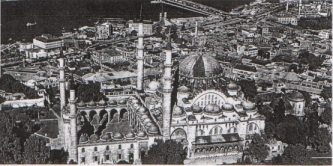
| Ottoman Architecture: Relationships Between Architectural Design and Mathematics in Architect Sinan's Work |
|---|
Yildiz Technical University
Istanbul, Turkey
The Classical period of Ottoman architecture is sometimes referred to as the "period of architect Sinan" because the most original and monumental religious and public buildings in this period were created by this great master builder. In Sinan's architecture, the most important element is the dome, which forms the central point of the whole structure; therefore the overall structure of the building is oriented towards carrying and supporting the dome. The system of relationships between the elements establishing the dimensions and constituting the buildings has been based upon the dimensions of the human body. These dimensions were observed in storey layers related to the facade, in the choice of the proportions of building elements such as windows and doors, and in calculating the proportional relations of such elements/details. Sinan, who was called "the Euclid of his age", developed a system of forms through an understanding of architecture based on geometry, and through the consideration of functions. According to Freely, "Euclidean geometry had a certain influence on Sinan's spatial compositions as well as the rules of construction". It can be said that the key that allowed intensive building activities to spread throughout the large geographical area ruled by the Ottoman Empire is the fact that Sinan had a common system of design in all his constructions.

One example of Sinan's use of mathematical principles is found in the Suleymaniye Mosque with its huge dome placed at the epicenter of the complex design. According to Ernest Egli, the proportion between the width and the length of the big courtyard, in which the mosque and the enclosed cemetary (hazire) are located, is 2/3, which is equal to the proportion between the axes. Again, measuring along the vertical axis, Egli established a regular increase in the spaces covered by the outer courtyard, inner courtyard, the area covered by the mosque building itself, and the enclosed cemetary, which corresponds to 4, 5, 6 and 7. On the horizontal axis, the measuements of the widths of the outer courtyard on the right, the space covered by the mosque building itself, and the outer courtyard on the left correspond to 4 ,7 and 4. As for the measurements of the specific spaces, the inner courtyard is 5/7, the space covered by the mosque building is 6/7, and the space of the enclosed courtyard is 7/7.
ILLUSTRATION: The Suleymaniye Mosque by Architect Sinan.
ABOUT
THE AUTHOR
Zafer
Sagdic,
research asistant in the History of Arts & Architecture Department
of Yildiz Technical University, is a Turkish architect living
and working in Istanbul. She received her degree from the Faculty
of Architecture of Yildiz Technical University in Istanbul, and
in Architecture History from Istanbul Technical University in
1999. She is working on the relationships between mathematics
and architectural design, especially in Seljuck Architecture,
Ottoman Architecture and Islamic Architecture. She has published
numerous articles on the relationships between architecture and
mathematics and presented papers at the M&D98 and the ISAMA99
conferences in San Sebastiano, Spain.
|
Zafer Sagdic, "Ottoman Architecture: Relationships Between Architectural Design and Mathematics in Architect Sinan's Work", pp. 123-132 in Nexus III: Architecture and Mathematics, ed. Kim Williams, Pisa: Pacini Editore, 2000. http://www.nexusjournal.com/conferences/N2000-Sagdic.html |
|
|
|
|
